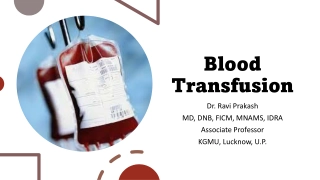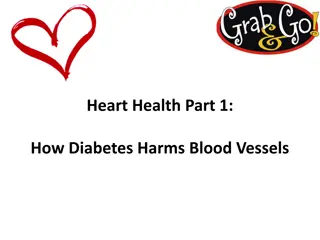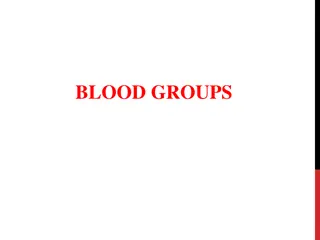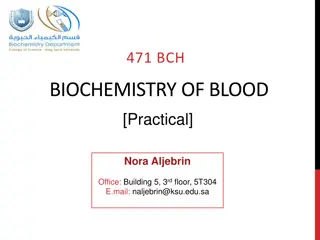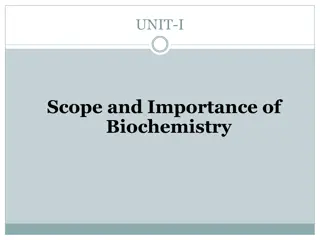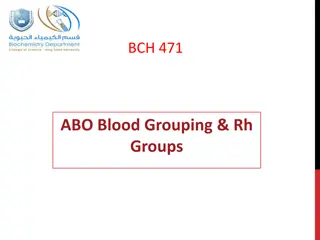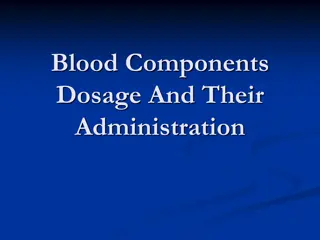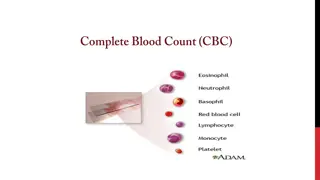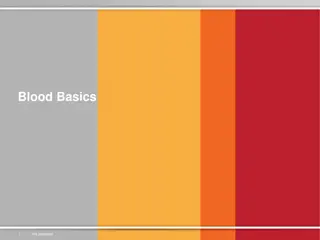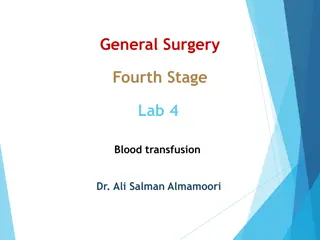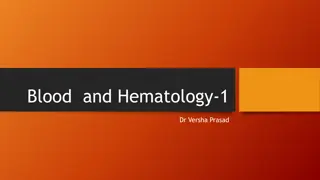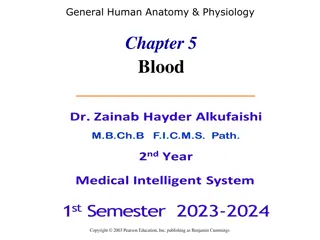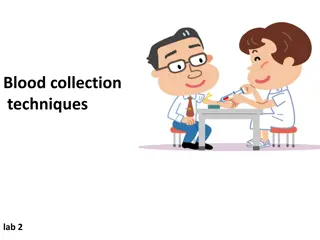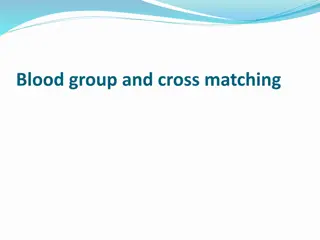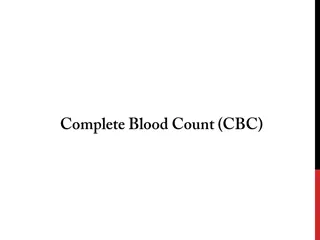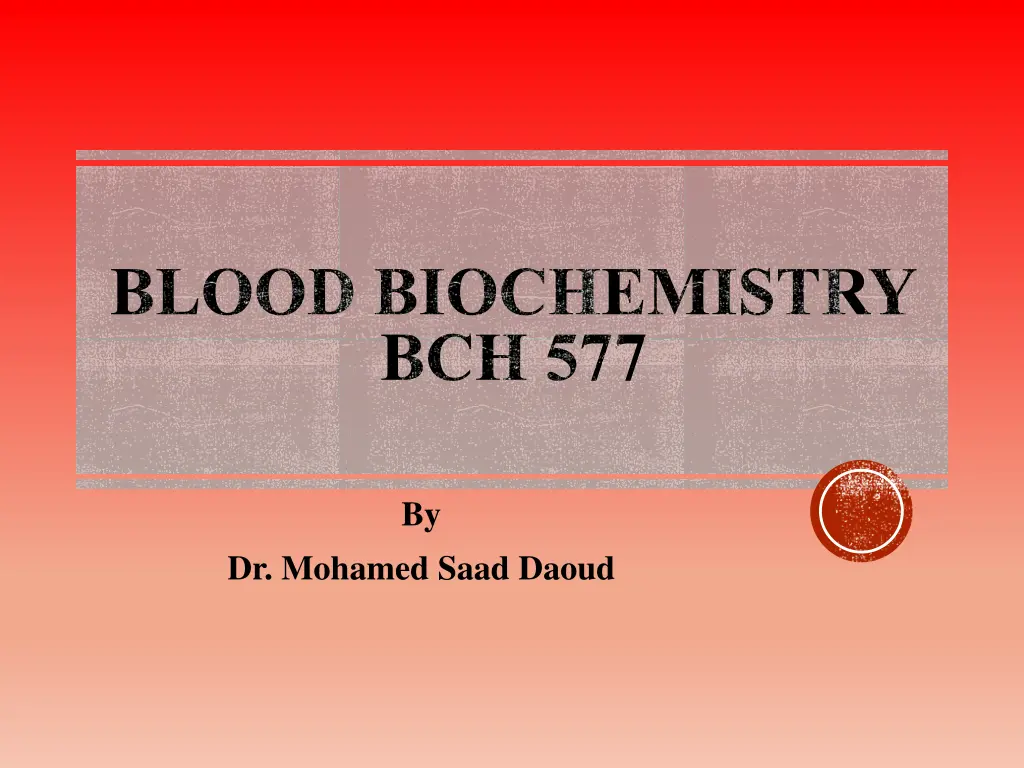
Blood Transfusion and Components for Medical Purposes
"Learn about blood transfusion procedures, purposes, and components for medical transfusions. Understand the importance of whole blood, packed red cells, fresh frozen plasma, and cryoprecipitate in treating various conditions. Explore the process of collecting and administering blood, as well as the testing involved in ensuring safe transfusions."
Download Presentation

Please find below an Image/Link to download the presentation.
The content on the website is provided AS IS for your information and personal use only. It may not be sold, licensed, or shared on other websites without obtaining consent from the author. If you encounter any issues during the download, it is possible that the publisher has removed the file from their server.
You are allowed to download the files provided on this website for personal or commercial use, subject to the condition that they are used lawfully. All files are the property of their respective owners.
The content on the website is provided AS IS for your information and personal use only. It may not be sold, licensed, or shared on other websites without obtaining consent from the author.
E N D
Presentation Transcript
BLOOD BIOCHEMISTRY BCH 577 By Dr. Mohamed Saad Daoud
Blood transfusion Blood transfusion is the transfusion of the whole blood or its component such as blood cells or plasma from one person to another person. Blood transfusion involves two procedures that is Collection of blood from donor Administration of blood to the recipient. 2 Dr. Mohamed Saad Daoud
Purposes of Blood Transfusion To restore the blood volume when there is sudden loss of blood due to hemorrhage. To raise the Hb level in cases of severe anemia To treat deficiencies of plasma protein, clotting factors or hemophilic globulin etc. To provide antibodies to those persons who are sick and having lowered immunity. To replace the blood with hemolytic agents with fresh blood To improve the leucocyte, count in blood as in agranulocytosis. To fight infection in leucopenia 3 Dr. Mohamed Saad Daoud
Components of blood for transfusion Each unit of blood is tested for evidence of hepatitis-b, hepatitis-c, human immuno deficiency virus I&II and syphilis. The blood is then processed into sub-components. These are- Whole blood, Packed cell volume, Fresh frozen plasma, Platelets, and Cryoprecipitate 4 Dr. Mohamed Saad Daoud
Whole blood Whole blood is unseparated blood containing an anticoagulant preservative solution. One unit of whole blood contains- 450 ml of donor blood. 50 ml of anticoagulant-preservative solution. Hemoglobin approx.12g/ml & hematocrit 35%- 45%. No functional platelets. Stored between +2 and +6 degrees centigrade in a blood bank refrigerator. Transfusion should be started within 30 minutes of removal from the refrigerator and completed within 4 hours of commencement because changes in the composition may occur due to red cell metabolism. 5 Dr. Mohamed Saad Daoud
Packed Red Cells Packed red cells are cells that are revolved down and concentrated. One unit of packed red cells is approx. 330 ml and has a hematocrit of 50- 70%. They are stored in a SAG-M (saline-adenine- glucose-mannitol) solution to increase their shelf life to 5 weeks at 2-6 C Fresh frozen plasma Fresh frozen plasma is rich in coagulation factors. I t is separated from whole blood and stored at -40 to -50 C with a 2 year shelf-life. It is the first line therapy in the treatment of coagulopathic haemorrhage. 6 Dr. Mohamed Saad Daoud
Cryoprecipitate Cryoprecipitate is a supernatant precipitate of fresh frozen plasma and is rich in factor VIII and fibrinogen. It is stored at -30 C with a 2 years shelf life. Indicated in low fibrinogen states (<1g/l) or in cases of factor VIII deficiency (hemophilia-a), von will brand's disease and as a source of fibrinogen in disseminated intravascular coagulation. Pooled units containing 3-6 gms fibrinogen in 200-500 ml raises the fibrinogen level by approx. 1g/L. Must be infused within 6 hours. 7 Dr. Mohamed Saad Daoud
Blood grouping and cross matching Each person has one of the following blood types: A, B, AB, or O. O can be given to anyone but can only receive O. Type O blood is called the universal donor AB can receive any type but can only be given to AB. People with type AB blood are called universal recipients. Also, every person's blood is either, Rh-positive or Rh-negative. People with Rh-positive blood can get Rh-positive or Rh-negative blood. But people with Rh-negative blood should get only Rh- negative blood. The blood used in a transfusion must be compatible with the patient's blood type. 8 Dr. Mohamed Saad Daoud
Type of blood transfusion Allogenic blood transfusion (someone else blood) Autogenic blood transfusion (own blood) Exchange blood transfusion 9 Dr. Mohamed Saad Daoud
General instruction Selection of donor Donor should be free from diseases such as TB, cancer, jaundice or any other transmissible disease. Make sure that donor has not donated the blood within previous 90 days. Physically active, between the age of 18 to 65 years with an average height and weight. Donor must have normal vital signs. Must not have been pregnant within the last 6 months. Hb level must be above 12gm%. Donor should be disqualified who have history of recent dental surgery, major surgery, receipt of blood or blood component, immunization etc. 10 Dr. Mohamed Saad Daoud
Explain the procedure to the donor. Blood should not be collected empty stomach, should not be dehydrated. Following the donation donor should be offered sweetened drink and asked to take rest at least for 1-2 hrs. to prevent faint Before leaving the collection center donor must be observed for any giddiness, color changes. Check vital signs frequently. 11 Dr. Mohamed Saad Daoud
Collection, storage and transportation of the blood Donor s blood immediately after it is withdrawn should be placed in the refrigerator. Stored blood should be inspected daily and before use for evidence of hemolysis or bacterial contamination. The transportation of blood in the hospital should be done within 30 minutes after it is taken from the place of storage. If the blood is kept at room temperature the temperature of blood will rise above 10 C in 30 minutes. If blood is not used it should be returned to the refrigerator within half an hour. 12 Dr. Mohamed Saad Daoud
When blood is transported to distant place use precooled insulated bags to keep the temperature of blood below 10 C. Collection of blood from the donor is done in laboratory by laboratory technician. Donor s blood is collected in a sterile container containing anticoagulant solution (ACD). All the articles used for the collection of blood must be sterile. Each donor unit must be labeled clear readable letters i.e.- name, donor no. ABO grouping, Rh typing, date of drawing, date of expiry and result of tests for hepatitis, and syphilis. 13 Dr. Mohamed Saad Daoud
Administration of blood to the recipient When sending the recipient s blood sample for grouping and cross matching, it must be clearly labeled with name, IP number, bed number, ward no. Fresh sample taken within four hrs. should be used for typing and cross matching. A request form should accompany with blood sample and form should contain- name, IP no. bed no. ward no. name of the physician, exact amount of blood component required, diagnosis of the patient, any blood transfusion given earlier, if so, the group and type of blood administered any reaction observed. It is essential that the physician writes all orders for typing, cross matching and administration of whole blood or blood products. 14 Dr. Mohamed Saad Daoud
Prior to administration of blood two registered nurse or a physician and a registered nurse should verify all information s on the report of the cross match, unit label, and the patient s identifications. If there is any discrepancies the unit should be returned to the blood bank with remarks. Whole blood or blood should be transfused through an appropriate, sterile transfusion set containing a filter. Transfusion set should be free from air. Use 18-gauge needle for transfusion. No medications or other additives should be given the same IV route or should not be mixed with blood. Keep the patient warm and comfortable if necessary. Offer bedpan before starting the procedure and as necessary. 15 Dr. Mohamed Saad Daoud
Record the amount of blood, type and group, rate of flow, any reaction and any medication administered. If IV infusion is to be given before, after or during the transfusion always use the normal saline. Prior to transfusion record the vital signs of the patient to provide the baseline for further observation. Adjust the rate of flow to 5-10 ml per minute during the first 30 minutes of transfusion to detect any complications as early as possible. Allow the blood to remain at room temperature prior to administration of blood. Watch for any complications throughout the procedure 16 Dr. Mohamed Saad Daoud
Complication of Blood Transfusions Blood transfusion reaction is a systemic response by the body to blood incompatible with that of recipient It is mainly caused due to: ABO incompatibility Allergic reactions to the WBCs, platelets, or plasma protein components of the transfused blood Potassium or citrate preservative in the blood. 17 Dr. Mohamed Saad Daoud
Types of blood transfusion reactions Acute hemolytic transfusion reaction Develops during the first 5-15 minutes. In hemolytic transfusion reaction circulating RBCs are ruptured with the release of hemoglobin. 18 Dr. Mohamed Saad Daoud
Causes of acute hemolytic reaction ABO incompatibility Rh incompatibility Improper storage of blood Uncontrolled refrigeration of blood resulting in freezing Storage beyond 21 days limit Warming of blood above 40 C Exposure of blood to dextrose solutions. 19 Dr. Mohamed Saad Daoud
Clinical features of acute hemolytic reaction Onset of fever Chills, headache, dyspnea, cyanosis, chest pain Nausea, vomiting Increased heart rate and respiratory rate Hemoglobinuria Complications include: Hypotension followed by shock, Oliguria then anuria followed by renal failure 20 Dr. Mohamed Saad Daoud
Delayed hemolytic transfusion reaction Occurs due to incompatibility of RBC antigens other than ABO group. It develops days to weeks after transfusion. It is featured by persistent decrease in Hb level and low grade fever. Many time this reaction is missed, if known inform the physician and blood blank. 21 Dr. Mohamed Saad Daoud
Pyrogenic reaction It develops immediately or within 6 hrs. of infusion. It results from pyrogenic substances from the tubing s. Causes of pyrogenic reactions Improper preparation of donor s site Not following proper aseptic technique Antigen and antibody reactions to WBCs and platelets contained in blood product. Improper refrigeration 22 Dr. Mohamed Saad Daoud
Clinical features Fever with chills Nausea, vomiting and diarrhea Headache Backache Delirium, shock and renal failure Prevention Proper screening of donor Use of disposable and pyrogen free sterile syringes and tubing for collecting and transfusing the blood. Proper technique for storing the blood. 23 Dr. Mohamed Saad Daoud
Allergic reaction It develops any time or within one hour of transfusion. Allergic reactions are the result of sensitivity of the individual to the plasma protein in the transfused blood. It is characterized by itching, rashes, laryngeal edema and bronchial spasm in severe cases. Treatment normally include injections of antihistamines and corticosteroids as necessary. 24 Dr. Mohamed Saad Daoud
Anaphylactic reaction Extremely rare but life threatening. Develops immediately after transfusion of few ml. of blood. It is caused by idiosyncratic reaction in clients with IgA deficiency. It is characterized by sever cardio-respiratory features such as- dyspnea, cyanosis, tachypnea, tachycardia, hypotension and collapse. Immediately transfusion is stopped and inform to physician and resuscitative measures are started. Monitor the vital signs every 15. min until patient recovers Transmission of infectious diseases 25 Dr. Mohamed Saad Daoud
Complications of blood transfusion Circulatory overload Giving whole blood to patient with severe anemia is very dangerous as patient require the RBCs not the other component of blood and may develop circulatory overload. Condition of heart failure may also cause the circulatory overload with blood transfusion. 26 Dr. Mohamed Saad Daoud
Prevention of Circulatory overload Use packed RBCs instead of whole blood Administer diuretics prior to blood transfusion to reduce the plasma volume Transfuse the blood at a slow rate Check the patient s pulse at every 15 minutes. Check the patient s neck vein for fullness Observe the central venous pressure (CVP), if it is greater than 10 cm of water indicates circulatory overload Observe for the signs of respiratory distress Give minimum quantity of blood at a time Stop the transfusion and inform to the physician if patient develops the sign and symptoms of circulatory overload. 27 Dr. Mohamed Saad Daoud
Hyperkalemia Stored blood may cause hyperkalemia. Blood that is one-day old has plasma potassium content approximately 7mEq/litre and 21 days old blood contains about 23 mEq/litre. Hypocalcemia It develops due to citrate toxicity. During massive transfusion citrate in the blood combines with ionized calcium and tetany may result. Higher level of citrate may cause cardiac arrest. Treatment consist of administration of calcium gluconate to prevent or eliminate the toxic effects by neutralizing the acidosis 28 Dr. Mohamed Saad Daoud
Hemosiderosis It is also known as iron over load. It may develop in clients receiving frequent blood transfusion. Hemosiderosis is an abnormal deposition of iron in various tissues in the form of hemosiderin which is an iron rich pigment that is the product of hemolysis Infiltration and Hematoma Thrombophlebitis Pulmonary embolism 29 Dr. Mohamed Saad Daoud

